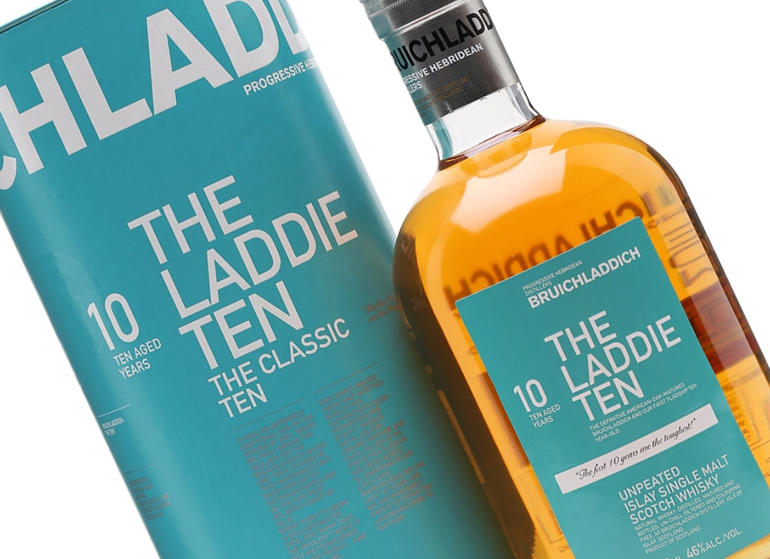Nose: Honey, lemon, shortbread, honeydew melon; hints of vanilla, and the slightest waft of sea-spray. Quite a few fresh yet mellow florally notes hiding in there as well.
Palate: The nose really gives it away with this whisky – mostly what you smell is what you get, which is by no means a bad thing as the nose is delicious. The palate really does just continue on from the nose, adding some candied winter fruits and a scattering of sultanas with just a hint of oak spices present as well.
Mouthfeel: Gloriously thick and dry with little to no oils present at all – although not quite as thick as the new Islay Barley series from Bruichladdich. Also the slightest alcohol tingle, one that lightly slaps the tip of your tongue, but has disappeared by the time it’s gone even halfway back.
Finish: Quite long – especially for a ten year old. A few oils do show up now, but only help to keep the taste lingering on.
[divider]
The very first line on Bruichladdich’s page for this whisky sums up pretty well how important this whisky was for the re-birthed Bruichladdich under Reynier and McEwan: “This is without doubt the most important release in our history“.
This was the whisky that put Bruichladdich back on the Scotch map, and grew the numbers of Bruichladdich disciples by an enormous amount. It was the first age-statement whisky that only contained malt that had been distilled after Bruichladdich’s re-birth, it was completely delicious, and a bigger departure from the standard Islay peated whiskies could not have been made. There is also, from what I have heard, a very real chance that Bruichladdich would not have survived if the Laddie Ten was not successful. Fortunately the Laddie Ten was more successful than anyone had thought it would be, and Bruichladdich is still here. This is fantastic – as Bruichladdich is one of my favourite distilleries.
Bruichladdich was originally founded by William, John, and Robert Harvey in 1881, and was the first purpose-built distillery on Islay. The Bruichladdich distillery was state of the art when it first opened, and not a lot has changed since – with many of the original Victorian-era equipment that was installed by the Harvey brothers still in use today, where it is still operated and maintained by hand not by computer. After a downturn in the whisky industry, and numerous amalgamations amongst Scotland’s distilleries, Jim Beam, which owned Bruichladdich at the time, shut the distillery down as it was “surplus to requirements”. Fortunately they left pretty much everything in place, and brought a team over from the Jura distillery for a couple of months in 1998 – which proved that everything still worked. The distillery was then bought in December 2000 by a consortium that was led by Mark Reynier, and distilling began again in 2001 with Jim McEwan as head distiller.
There has recently been a changing of the guard at Bruichladdich, with Rémy Cointreau purchasing the distillery in 2013 – at which point (then CEO) Mark Raynier – who voted against the proposal to sell – left the company and the distillery. He is now in the process of starting a new distillery in Waterford, Ireland – where he is not just continuing the philosophy of Terroir Matters that he and Jim started at Bruichladdich, but is taking it to a whole new level. In 2015 Jim McEwan also retired, leaving long time protege Adam Hannett in charge of distilling. It is not quite a complete clean slate though despite new owners, new head distiller, and new CEO – as the new CEO is Simon Coughlin, who has been there from the re-birth – and was part of the founding partners with Mark Reynier.
A large part of what helps give Bruichladdich it’s distinctive taste and feel is the speed at which everything is produced at the distillery. All the malt is “trickle distilled” in their 6m tall gravity-fed stills after being mashed in Scotland’s largest open-top mash tun, and slowly fermented in a large wooden (douglass fir) washback. Everything about Bruichladdich’s whisky is slow and deliberate, which results in generally high-quality whiskies – of which the Laddie Ten is one.
The Laddie Ten is an extremely well balanced whisky with smooth flavours, and a thick, dry ,solidly built texture without being so smooth that it is without any character – in some ways it seems that the whisky needs to be this thick to be this smooth with the rich weave of flavours that make it up, as if they wouldn’t stay together if it was any less thick. If this whisky was a Rugby player, it would be a hooker – slow and methodical, yet ready to fight with all guns blazing when the timing is right.
Unfortunately, Bruichladdich has ended production of the Laddie Ten. They have done so not because sales weren’t as high as expected, but rather because they were too good. I realise you are most likely thinking that they’re nuttier than aeroplane snacks right about now, but it does actually make sense – the Laddie Ten was so popular, and was so important to the resurrection of the distillery, and quite possibly a lucky result of the weather and soil conditions at the time the barley was farmed, that Bruichladdich decided that the Laddie Ten was a special vintage; and that trying to recreate it would diminish the history of those that had already been bottled and sold.
The Laddie Ten has since been replaced with the Laddie Classic, which I will review at another time.

